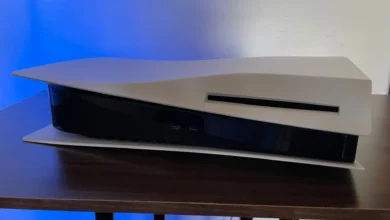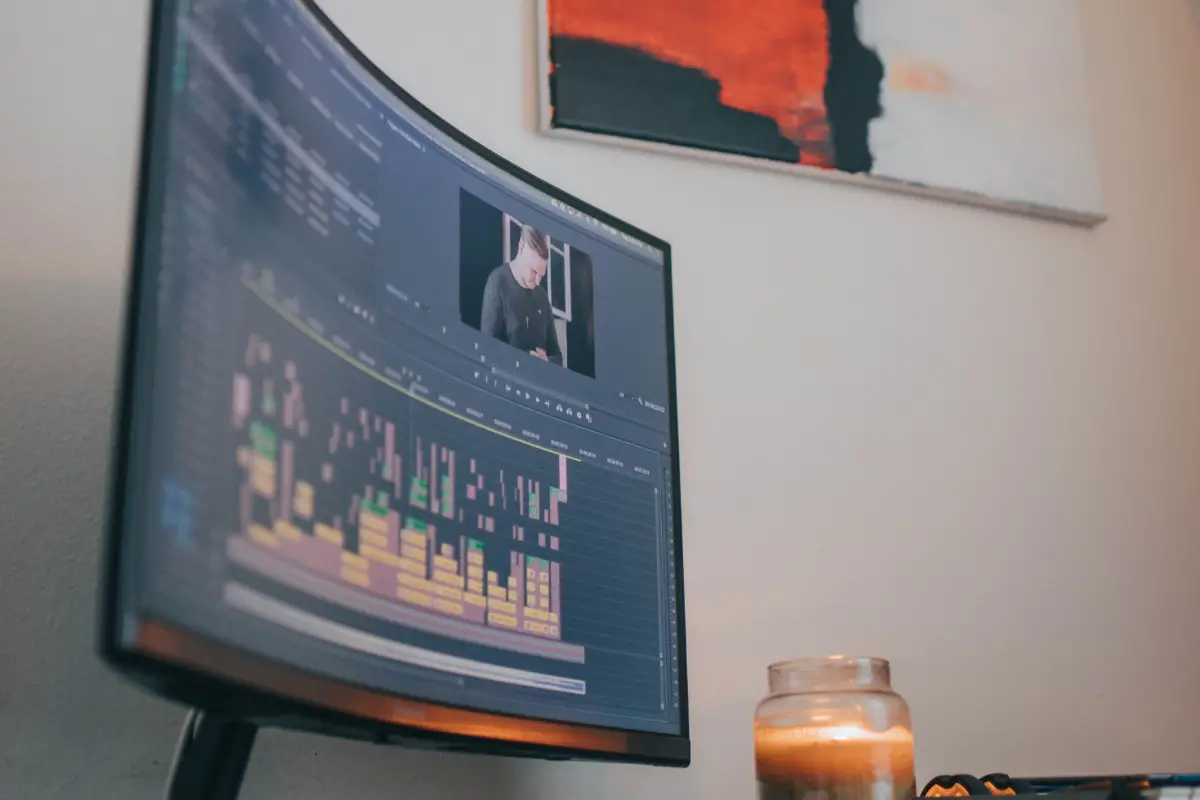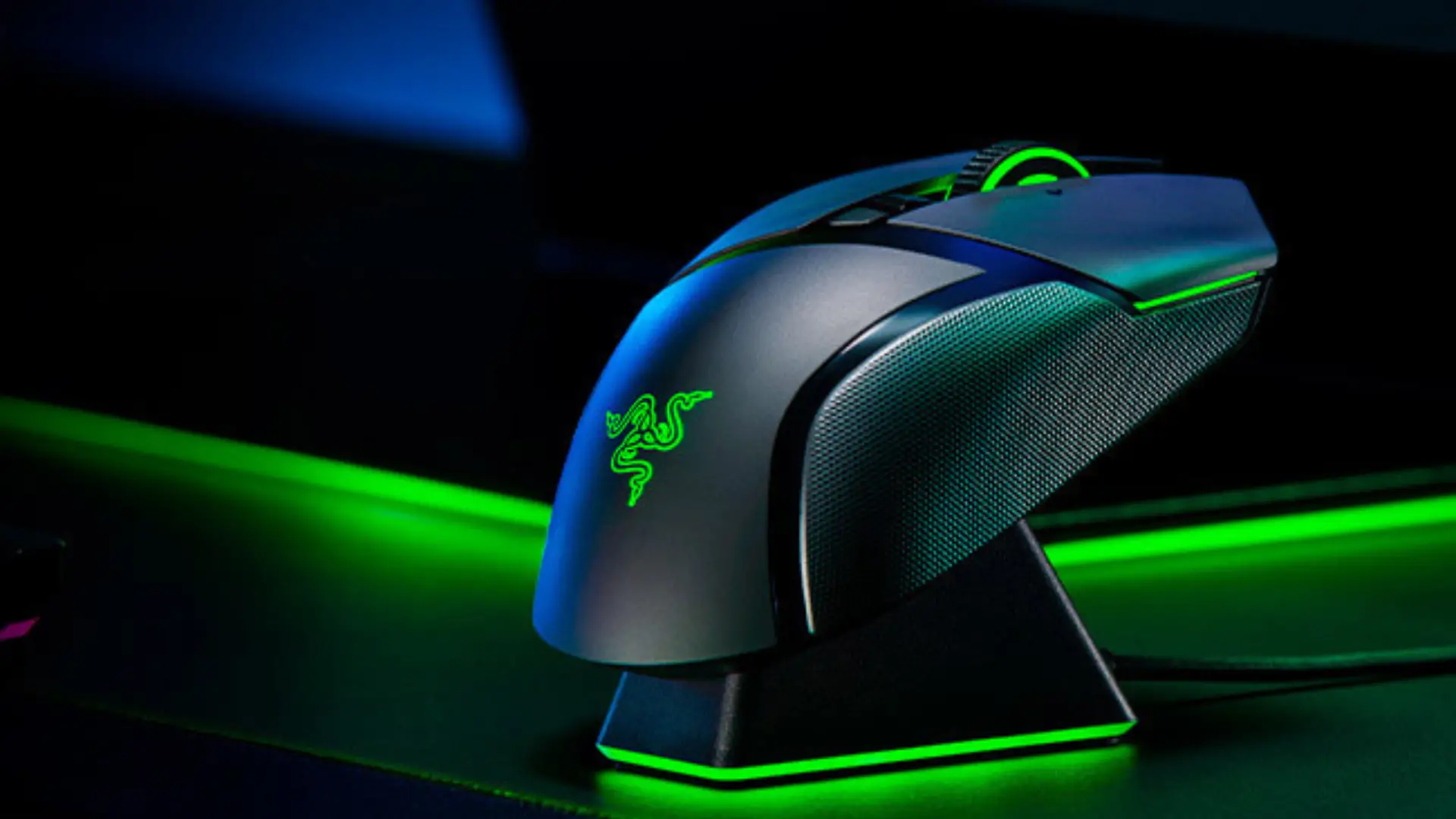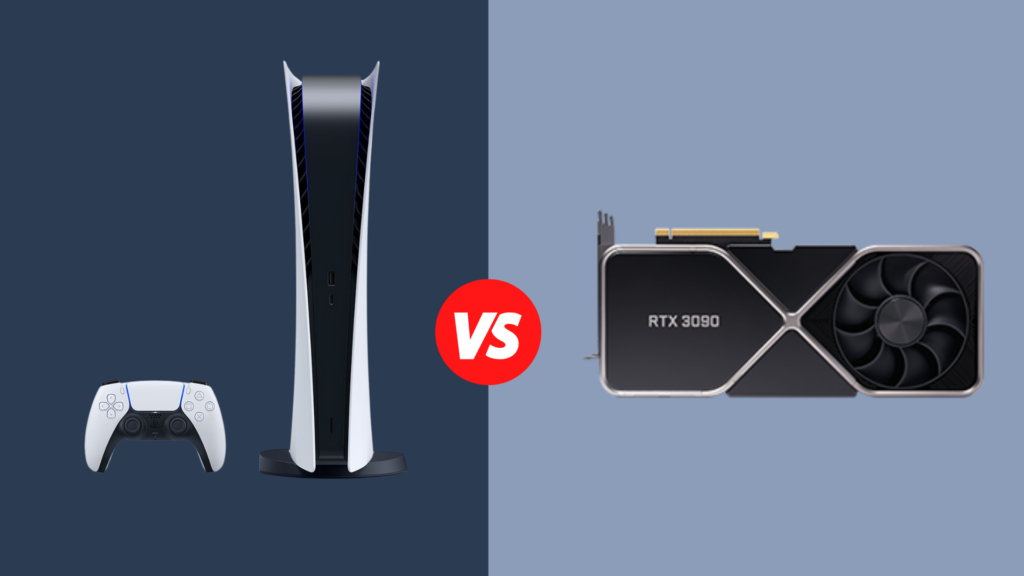
Generally speaking, people who consider themselves hardcore gamers and/or gaming hardware enthusiasts are known for wanting to stay informed about what’s called the “bleeding edge” of technology — the very latest products in terms of advanced capabilities and specifications.
One of the longest-running battles between different factions of this crowd is what performs better for gaming (in terms of outputting smoother, higher-quality images): one of the latest and most popular video game consoles, or a high-end PC equipped with an ultra-powerful graphics card (and the cooling devices needed to keep it running at a reasonable temperature).
For the purposes of this article, we’re going to compare one of today’s most popular gaming consoles, the Sony Playstation 5 (PS5), with one of the most highly regarded PC graphics cards on the market, the NVIDIA GeForce RTX 3090.
The PS5 was introduced in 2020 and has since gone on to sell more than 20 million units, becoming the fastest-selling video game console in history, while NVIDIA’s GeForce series of graphics cards have experienced impressive sales of their own for their category (as just one indicator of this, NVIDIA’s online store went down on the day the RTX 3090 was launched due to surging demand).
Strictly speaking, however, the number of RTX 3090 cards sold is just a small fraction of the quantity of PS5 units Sony has sold. This has to do with the relative pricing of both products (the PS5 is roughly one-third the cost of the RTX 3090), but also with the paucity of measurable differences between them.
This article will examine both devices, their specifications, and the realities of their performance, in addition to comparing the differences between both products.
A Closer Look at the Playstation 5
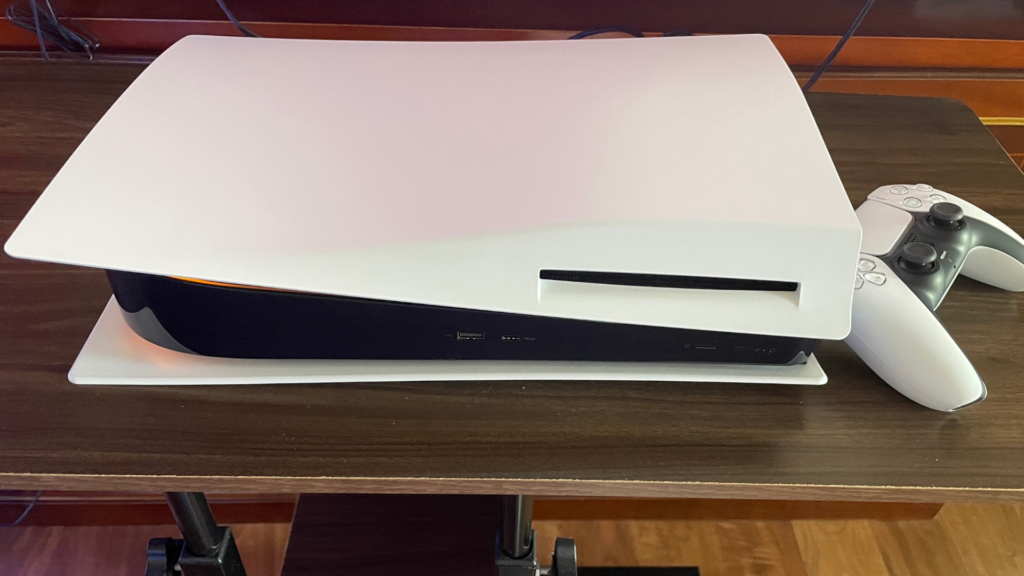
The original Sony Playstation was introduced in December 1994 in Japan after Sony had unsuccessfully tried to co-develop an advanced game console with Nintendo. Initially, the Playstation’s best-selling games were 3D titles Ridge Racer, Tekken, and Wipeout. But after a nearly unheard-of 12 years of production, the best-selling game for the original Playstation turned out to be Polyphony Digital’s Gran Turismo, a game that would go on to be used as a benchmark for 3D graphics performance on consoles and PCs alike.
It took 26 years for the Playstation to go from its first-generation model, which integrated a 33.8 MHz LSI CoreWare CW33300-based core and operated at 640 x 480-pixel resolution, to the eagerly anticipated fifth-generation model, the PS5, which uses a 3.5 GHz custom processor developed by Sony and AMD and outputs 4K UHD resolution.
In between these iterations, the Playstation gained a fast solid-state drive (SSD) for storage, an Ethernet port and Internet connectivity, the Playstation Network and Playstation Now social/streaming gaming services, the capability of playing DVDs and Blu-Ray discs, motion-sensing and haptic feedback controller technology and the ability to stream games to other devices like the Playstation Portable and Playstation Vita.
PS5 Specifications
As mentioned previously, the PS5 uses a custom 3.5 GHz 8-core AMD Zen 2 system-on-a-chip (SoC) processor with 10.6 billion transistors developed by Sony and AMD that integrates a 2.23 GHz AMD RDNA2-based variable-frequency custom graphics processing unit (GPU). The PS5 also utilizes 16 Gb of GDDR6 256-bit SDRAM and an 825-Gb SSD (of which some 667 Gb are usable).
This kind of hardware is rarely seen outside a personal computer and effectively makes the PS5 an ultra-fast PC that’s dedicated to just one task: gaming. The incredibly powerful GPU is capable of peak theoretical performance of 10.28 teraflops (one teraflop is equivalent to one trillion mathematical operations per second). This allows the PS5 to play back moving graphics at rates up to 120 frames per second (fps), a speed so fast that it can outmatch the refresh rate of some televisions and computer monitors (see below).
Some other specifications the PS5 boasts are 2,304 shading units/compute unified device architecture (CUDA) cores, 36 compute units/ray tracing (RT) cores, 144 texture mapping units, a 321.6 GTexel/s texture fill rate, 64 render output units (ROPs), a 448 Gb/s memory bandwidth, 6 nm manufacturing process technology and 180-watt thermal design power.
The PS5 supports 4K resolution output at a 120 Hz refresh rate (that can match the 120 fps graphics speed mentioned above), which is significantly better than previous Playstation specs. It also features an HDMI 2.1 port that supports this output.
PS5 Performance Reality
One of the primary capabilities that the PS5’s GPU delivers is ray tracing, which previous Playstation models could only approximate or simulate using other techniques.
Ray tracing is a term in 3D computer graphics for realistically modeling the way light moves, as used by a wide range of rendering algorithms. Real-time ray tracing is the rendering in real time of 3D graphics typically used for movie CGI work and photorealistic art. Most ray tracing previously took so much computing power that it had to be set up in advance and executed slowly over time. Being able to execute ray tracing in real time on a consumer-level console like the PS5 is a breakthrough that delivers visible benefits for gamers in terms of more realistic 3D characters, images, lighting, and effects.
The PS5 is capable of 4K/120 Hz output, but in order to display it, you’ll need a monitor that can take the PS5’s HDMI 2.1 signal (note that some monitors may be capable of either 4K or a 120 Hz refresh rate, but not both at the same time).
Also, to play some games in 4K at 120 fps, you may need to use the PS5’s “Performance Mode,” which may compromise gameplay in other ways, such as limiting the use of ray tracing (by contrast, games run in the PS5’s “Resolution Mode” may play in 4K but be limited to 60 fps or 30 fps).
PS5 games that support 120 fps include: WRC 9, Tony Hawk’s Pro Skater 1+2, Rogue Company, Rocket League, Rainbow Six Siege, Quake, The Nioh Collection (Nioh and Nioh 2), Monster Boy and the Cursed Kingdom, Knockout City, Ghost Runner, Fortnite, F1 2021, Doom Eternal, Dirt 5, Devil May Cry 5 Special Edition, Destiny 2, Call of Duty: Warzone, Call of Duty: Vanguard, Call of Duty: Black Ops Cold War and Borderlands 3.
Because of the above limitations, many players may choose to either play their games at the lower resolutions of 1080p or 1440p in order to get a higher frame rate (and/or ray tracing), or they may accept a lower frame rate in order to achieve higher-resolution/higher-quality output.
NVIDIA GeForce RTX 3090
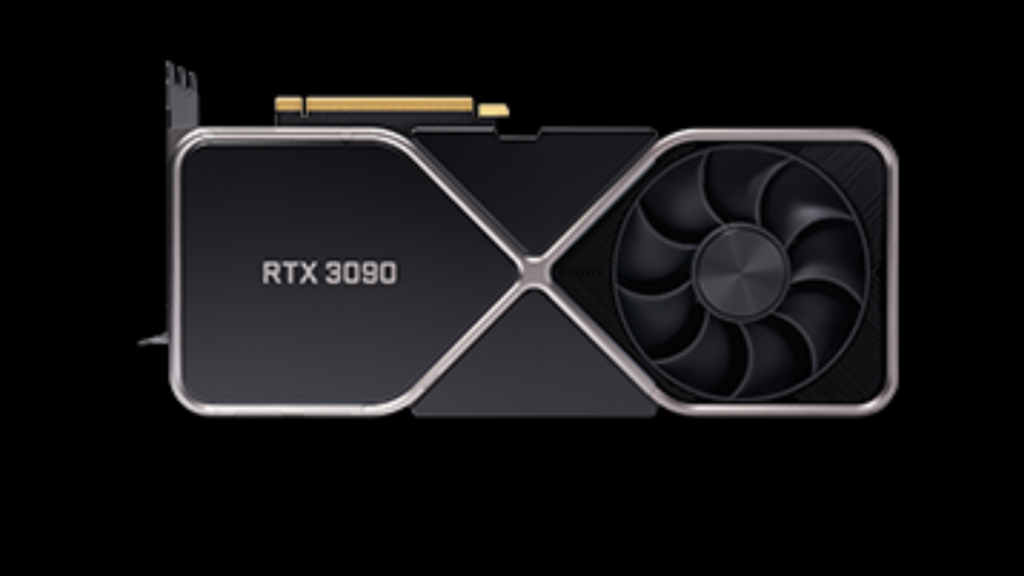
NVIDIA introduced the GeForce series of GPUs and cards in late 1999.
The RTX (which stands for Ray Tracing Texel eXtreme) 30 series of cards is the 16th series of GeForce products from NVIDIA and the second series (the first being the 20 series of cards) to incorporate ray tracing technology.
Within the 30 series, the GeForce RTX 3090, launched in 2020, is the next-to-top-of-the-line, developed by NVIDIA for architecture, product design, energy exploration, scientific visualization, film, video production, and gaming vertical markets (note how gaming appears at the end of this list).
The top 30-series model, the RTX 3090 Ti, features slightly faster clock speeds, more Tensor and ray tracing cores, and greater processing power; NVIDIA says both cards feature a “BFGPU,” or “big, ferocious GPU.”
The RTX series is able to do ray tracing in real time via a combination of software and hardware acceleration. In terms of hardware, the RTX 3090 features dedicated ray-tracing cores designed to accelerate the mathematical operations needed to simulate light rays.
The RTX 3090 integrates deep learning super sampling (DLSS) — an image enhancement and upscaling technology that simulates higher resolutions but actually operates at lower ones (4K, for instance, or even lower). DLSS takes advantage of Tensor cores and can offer up to a 100-percent speed improvement of ray tracing.
According to NVIDIA, the RTX 3090 is the first graphics card that’s designed for gaming at 8K resolution, but whether you’ll actually be able to play games at this resolution is another story (see the RTX 3090 Performance Reality section, below).
NVIDIA GeForce RTX 3090 Specifications
The GeForce RTX 3090 is built around the 1.395 GHz GA102-300-A1-variant of the NVIDIA Ampere-architecture GA102 GPU. With 28.3 billion transistors, it utilizes 24 Gb of GDDR6X 384-bit SDRAM and is capable of peak theoretical performance of 36 teraflops, allowing it to play back moving graphics at rates up to 360 frames per second (fps).
Other specifications the RTX 3090 can claim are 10,496 shading units/CUDA cores, 82 compute units/RT cores, 328 texture mapping units/Tensor cores, a 556 GTexel/s texture fill rate, 112 ROPs, a 936.2 Gb/s memory bandwidth, 8 nm manufacturing process technology and 350-watt thermal design power.
The RTX 3090 can support resolutions up to 8K and monitor refresh rates up to 360 Hz (but not both simultaneously). It offers a single HDMI 2.1 output and three DisplayPort 1.4a outputs.
Multiple RTX 30-series cards can be connected together using the NVIDIA RTX NVLink Bridge for even better performance.
NVIDIA GeForce RTX 3090 Performance Reality
One of the biggest let-downs of the RTX 3090 is that, even though it’s capable of outputting games at 8K resolution, not many gamers choose to take advantage of this — for two reasons. First is the cost; 8K displays are still incredibly expensive, and the benefit of this much resolution is just not very visible until your screen size is over 100 inches diagonally. Second, only select games can be played at an acceptable frame rate in 8K (if they’ll even play in 8K to begin with). Playing games in 8K or at high fps can heat up the RTX 3090 significantly. Some games will play in 8K, but only if DLSS (see above) is turned on.
At the same time, most hardware enthusiasts agree that using the RTX 3090 for gaming at resolutions lower than 4K is simply overkill. At 4K, decent frame rates of 60 fps should still be possible on the RTX 3090, although certain games (such as Cyberpunk 2077) can’t even get up to this rate without applying DLSS. Still, most observers are in agreement that just about every game will play in 4K on the RTX 3090.
Another consideration is that the RTX 30 series is only the second generation of NVIDIA GPUs to support ray tracing, so hardware that could be called “overkill” when it comes to this capability may be at least a decade away.
Bear in mind that the retail price of the GeForce RTX 3090 was already roughly three times the cost of the PS5 at its release. But global chip shortages that started in 2020 due to the coronavirus pandemic caused prices to increase; high demand and product scalpers meant that RTX 3090 prices remained at a premium for much of the last two years. It should also be pointed out that, by some measures, the NVIDIA RTX 3080 Ti is only 3% slower than the RTX 3090; the 3080 Ti only has 12 Gb of SDRAM compared with the 3090’s, but for many games, 12 Gb is more than adequate, and the 3080 Ti’s cost can be up to $1,000 less than that of the 3090.
Comparison
The RTX 3090 is roughly 3.5 times as powerful as the PS5. This can be seen in the higher resolution and frame rates afforded by the RTX 3090 as compared to the PS5. For instance, while the PS5 might be capable of outputting 120 fps when it’s “maxed out,” the RTX 3090 may be capable of two or three times that speed.
The dedicated hardware ray tracing cores on the RTX 3090 beat the PS5’s hardware-accelerated ray tracing in terms of crispness and realism. In general, due to this disparity, shadows and reflections may be missing from images on the PS5, and some graphics may look “smudged” or slightly blurry. Backgrounds and textures tend to be noticeably sharper on the RTX 3090. Still, these differences are likely to be VERY subtle; many games will exhibit virtually no differences from one platform to the other.
Real-world Analysis
There are many industry observers who believe that the RTX 3090 is really meant for professional workstations (because of its price) and that its use in gaming is a “luxury” application.
A number of industry pundits claim that the PS5 GPU is roughly equivalent to the NVIDIA RTX 2070 (a much cheaper card than the RTX 3090) in terms of overall performance.
One vague rule to consider is that, these days, when buying a PC, each teraflop of performance costs roughly $150 if you include the expense of RAM and a CPU that will support increasingly powerful graphics cards. By this rule, a 10-teraflop equivalent of the PS5’s GPU should cost some $1,500, which will likely be close to the street price of the RTX 3090.
While most PC GPU cards come with at least 8 Gb of SDRAM as compared to the PS5’s 16 Gb, bear in mind that games only have access to roughly 12 Gb of this 16 Gb. Plus, PCs have their own separate RAM for their CPUs, whereas the PS5’s RAM serves both the CPU and GPU.
At the same time, to really deliver optimal output, a PC’s hardware and software settings often need to be painstakingly adjusted, whereas there are very few adjustments that need to be made (or that can even be made) on a console.
Still, it’s rare to find a gaming enthusiast who believes that a game played on a console is universally a better experience than the same title played on a PC. Ray tracing on a console, for instance, may be functional only for renderings of reflections, and not much else — hence, turning it off for the sake of improving performance may be a sound choice.
Due to inconsistent frame pacing on PCs as compared to consoles, PCs need more graphics power to run at acceptable frame rates (60 fps or better — at frame rates slower than this, PC output can look choppy). A PC’s GPU, therefore, must have double the power of the PS5’s GPU to play at 60 fps vs. the 30 fps that many gamers consider acceptable for the Playstation.
And finally, for 8K gaming, it may be smarter at this point to wait until display costs come down (and in the meantime, wait for the next generation of GPU cards).
Conclusion
While the PS5 generates lush, vibrant images, the output of the NVIDIA GeForce RTX 3090 is simply stunning and shockingly sharp, which is completely to be expected by a graphics card that costs three times as much as a standard PS5 console.
There are several takeaways from this, however. The first is that you could make the case that, given its cost, the PS5 performs outstandingly, especially when compared to other gaming consoles and PCs in its price range. The second is that, although the images from the NVIDIA GeForce RTX 3090 may be superior to those of the PS5, the differences (which are fairly marginal from a “big-picture” perspective) are hardly worth the large difference in price — especially when you factor in the cost of the rest of a PC that the RTX 3090 would fit into. This likely accounts for the relatively low number of RTX 3090 cards sold by NVIDIA, especially as compared to the number of PS5 units that have been sold around the world.
Thus, for many gamers, the minute differences that can be gained by spending $1,000-plus on an RTX 3090 will likely only be judged to be worthwhile by a very small percentage of hardcore gaming aficionados. Of course, it’s great that the option to “max” your PC out exists, but for many gamers, the “good enough” bar set by the PS5 is already so high that going beyond this level is a case of rapidly diminishing returns.
- NanoFlow Review 2025 – 30% OFF Big Coupon, Bonus
- NanoFlow OTO 1 to 6 Links – 30% OFF Big Coupon, Demo
- A2 Hosting Black Friday 2025: Get Up to 99% OFF (Live Now)
- GreenGeeks Black Friday Deals 2025 – Up to 90% OFF ( Live Now)
- Hostinger Black Friday Sale 2025 – Up to 90% OFF + Free Domain [Exclusive Deal]


